Creating top-quality case studies for your business is an investment—whether that’s critical time from your in-house team, or dollars spent with an external expert.
So why do so many B2B businesses play hide and seek with their case studies, burying them on their websites and making it difficult for prospects to find them?
Frankly, it’s a crime!
One SaaS business that doesn’t hide its case studies in a cupboard is revenue intelligence platform Gong.
When I discovered Gong’s B2B case study examples online, I saw a few things that I loved (and don’t see very often):
- Gong takes time and care in organizing their customer success stories so the right prospects quickly find what they want.
- Gong’s case studies are written with style, specificity, and humor, which reflects well on their position as a confident, customer-centric brand.
Join me as I swing my mallet (you know, that fluffy-ended stick!) at this SaaS case study example and explore how Gong gets the right prospects to engage and listen to their stories.
What is Gong?
Gong is a B2B SaaS firm. They provide technology and support for customers to analyze customer-facing interactions across phone, email, and web conferencing—then deliver the insights they need to close more deals.
Gong was founded by Amit Bendov and Eilon Reshef in 2015 and has grown to become a must-have tool in the modern tech stack. This article in Forbes tells their story. Gong’s current value is over $7bn.
How Gong makes it easy for prospects to find content that’s relevant
As soon as you visit the ‘Customers’ section on Gong’s website, it’s obvious they take the organization of their case study collateral seriously.
Studies are well organized, categorized and searchable (which we’ll explore more in a moment), so Gong’s prospects don’t have to scroll through case studies that aren’t relevant to find the gold.
Finding the gems in a sea of social proof
Let’s start from the top! Gong makes their case studies visible from the get-go with a dedicated ‘Customers’ tab in the menu bar. This compares favorably with other B2B businesses who hide studies beneath more layers of clicks in a general Resources section.
Even better, it’s the third tab after ‘Product’ and ‘Solutions’, showing customers are high priority for Gong.
Customer Stories is the first option you see when you click the ‘Customers’ tab. Once clicked, you’re greeted with a warm and colorful landing page and there’s a clear headline explaining what you’re about to get:
“See how our customers succeed with Gong.”
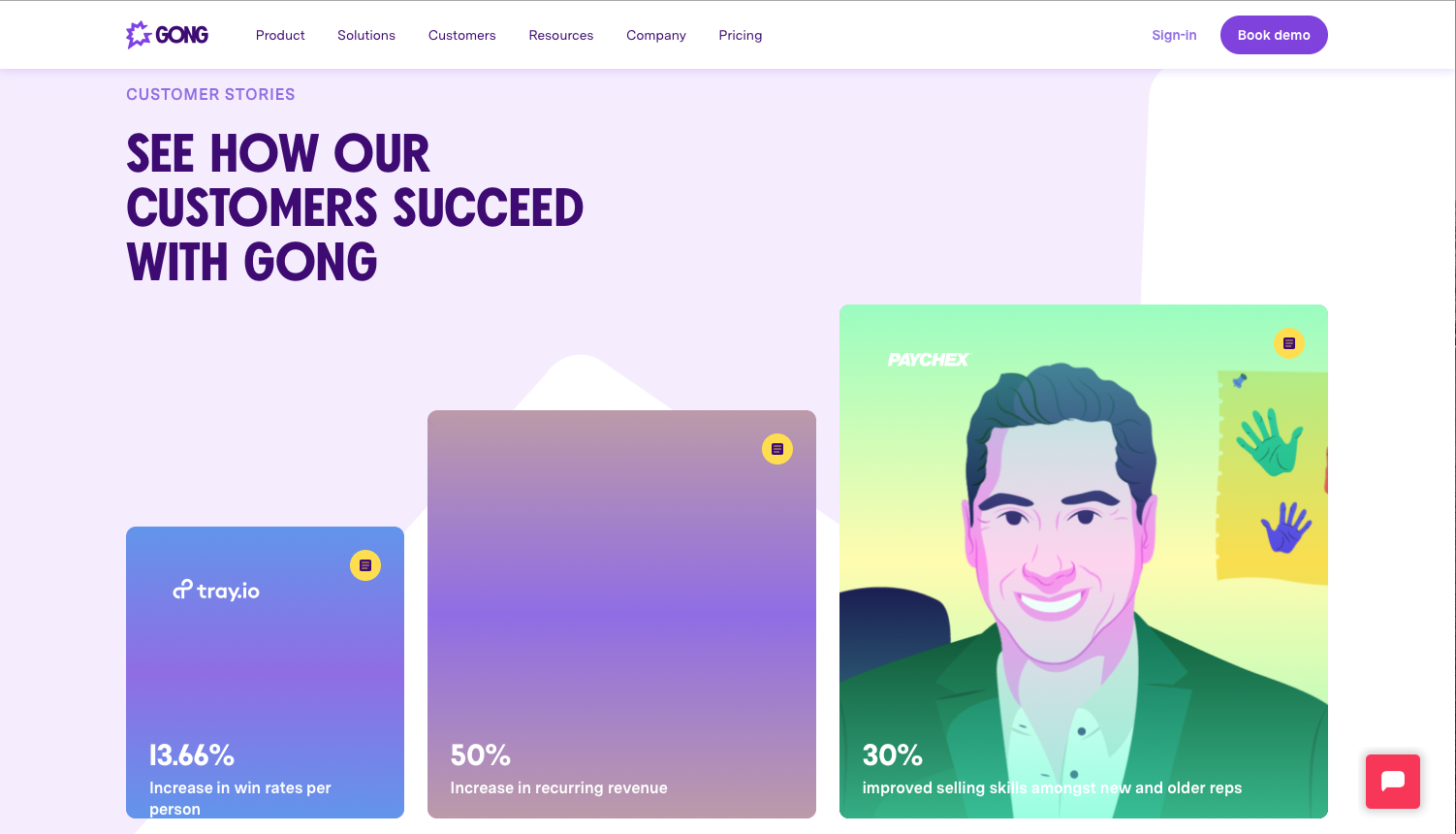
Three highlighted studies take center stage, providing just enough intrigue in the form of a logo, image, and juicy metric to encourage clickthrough.
But the real gold comes next.
Filters, tags, and pop-up pull quotes
The customer success stories on Gong’s website are organized in a grid pattern, which is pretty common, but they work harder than most to ensure prospects find what they need.
First up is a thorough filter function. Prospects can search by use case, industry, company size, and region. These are presumably based on the goals Gong knows leads come to their website with.

Having a filter option is essential, because Gong has a LOT of studies to sift through.
Nine studies appear on-screen initially, along with a button to load more. I hit the ‘load more’ button a few times to get a sense of the volume of studies Gong produces—and new studies were still appearing after nine clicks!
We can safely assume Gong values the impact case studies have on their sales and marketing funnels if they’re prepared to produce so many case studies.
With good filter options, prospects can easily find stories that are relevant to their specific sector or go deeper into other criteria that differentiate their business.
Another thing Gong does well is thoroughly tag each B2B case study example. On each story teaser, Gong includes a headline, image, and exhaustive list of touchpoints that each story hits…
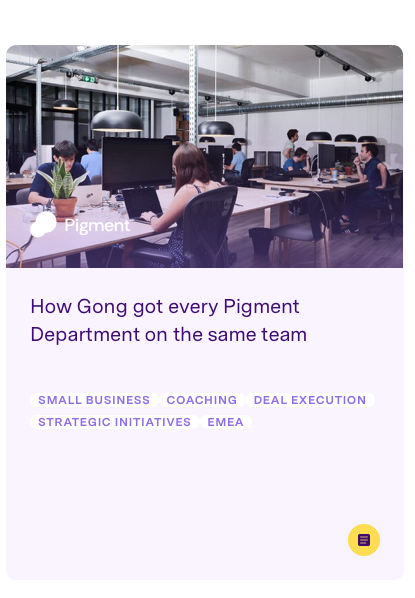
In this example, we see the customer’s company size, use cases for Gong’s product, and its region at a glance. So we immediately know if it’s relevant and worthy of our time.
Gong has even animated each study teaser. When you hover over one, a pop-up replaces the original image, featuring an enticing metric or quote and a prompt to ‘read the story’.
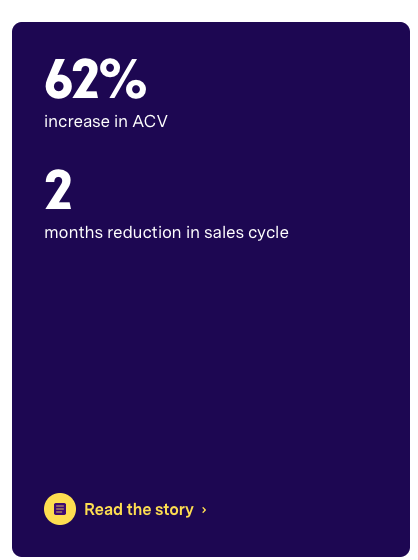
All of these elements show that Gong has a keen understanding of what its prospects are looking for—and makes it easy for them to get to the stories that best relate to their needs.
Organizing tags and filters takes time and effort. By doing it, Gong shows they respect their prospects’ time, put their customers first, and understand how their customer base is segmented.
That’s a lot of positive messaging communicated about their brand simply by organizing their case studies well!
Challenge and outcome summaries
While we’re talking about putting prospects and customers first, here’s another good example.
Imagine you’re a busy VP or Director of Sales looking for a solution that Gong can potentially solve. You’ve been convinced by the tags and filter that a story is relevant to you, and you’ve clicked ‘read the story’.
Here, Gong shows even more respect for your time by providing a snappy, scannable summary of the challenges and outcomes Gong solved and achieved for each customer.
This is great for anyone tight on time. It’s the perfect final nibble before you decide if you want to eat the whole biscuit.
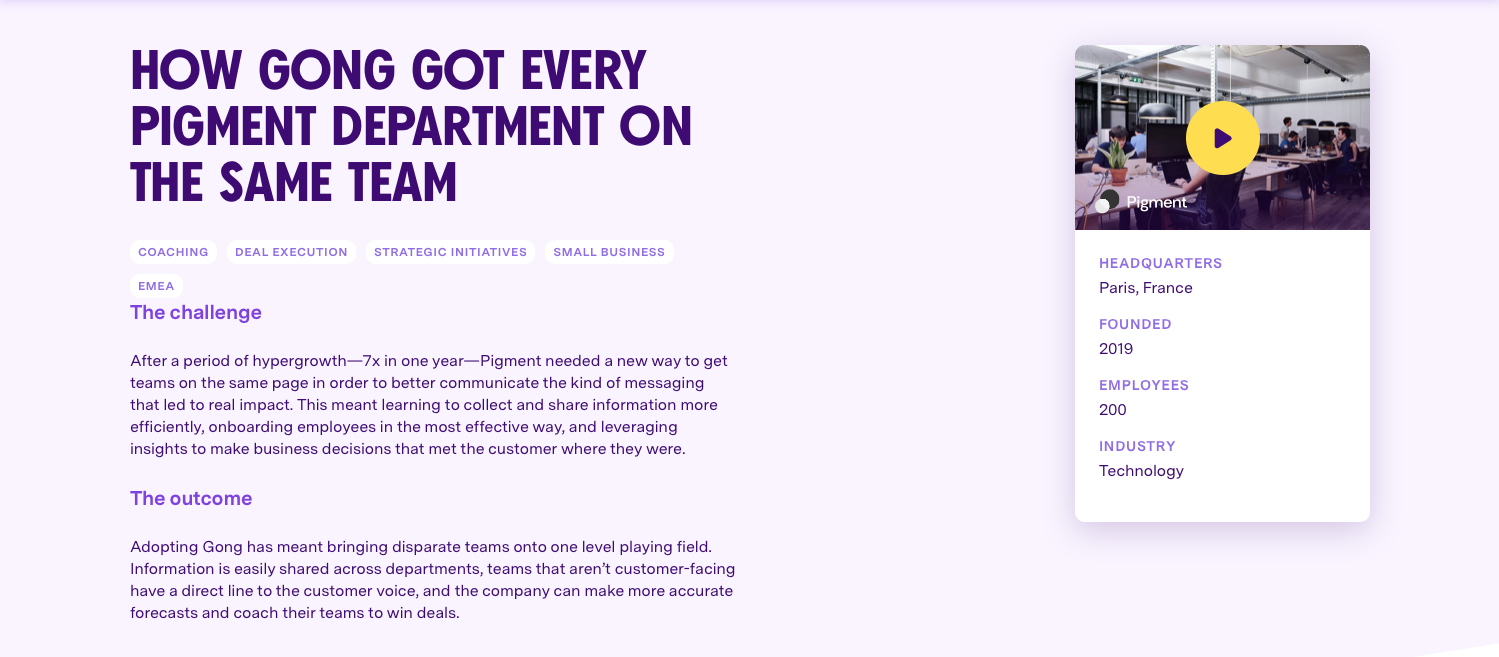
First-person stories with thought leaders
As we’ve seen, Gong is great at structuring SaaS case study examples so the right prospects find social proof for the product, solution or outcome they’re looking for.
Gong has another trick up their sleeve to make customer success stories appeal to a wider audience.
In a section called Lumineer Champions, they put a different spin on customer success. Here, they focus on Gong’s impact on individuals within customers’ businesses, rather than the businesses themselves.
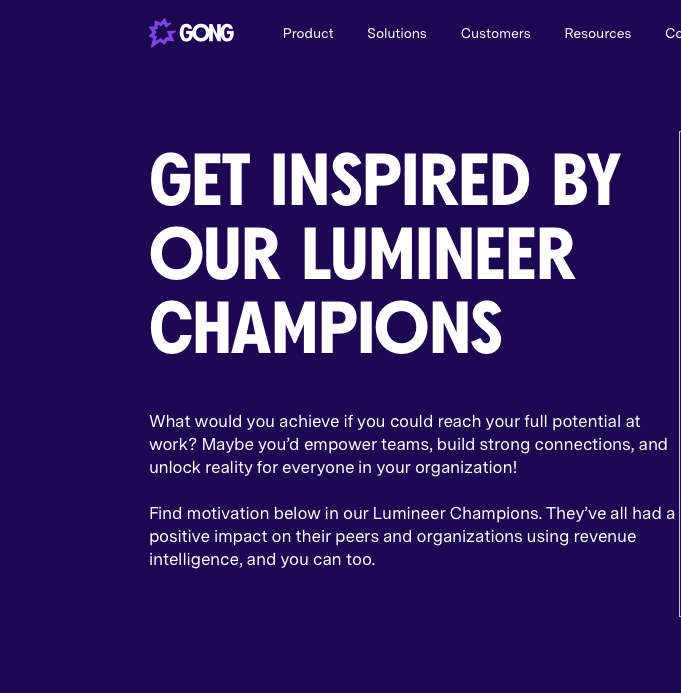
In one example with customer Hear.com, Gong complements their more traditional customer success story with a second, more personal Lumineer Champions video. This zooms in on the impact Gong has had on their VP of Sales personally, rather than the business at large. We watch the story unfold through his eyes.
This, and other stories in the section, showcase industry thought leaders who’ve successfully used Gong to benefit their teams, customers, and organizations.
It’s a nice idea for making customer case studies more personal and relatable to business leaders.
How they’re doing this on other platforms
So Gong are smashing it on their website. But are they as effective at promoting their studies—and making them appealing to the right people—on other platforms?
Let’s start with Google search.
When prospects search for Gong case studies, they see a great entry on the SERP. An enticing header ‘SEE HOW OUR CUSTOMERS SUCCEED WITH GONG’ is followed by three strong metrics that encourage you to click!

Gong also puts significant effort into their YouTube page. There, they include tips and guidance from in-house experts and have a dedicated section for video testimonials.
Like Gong’s written content (more on this soon), their video case studies are high quality and well produced.

The only criticism I have is that, unlike on their website, Gong doesn’t segment video testimonials. All studies sit in one homogenous section, so it might be more difficult for prospects to uncover the stories most relevant to them.
Another area where I feel Gong could potentially improve is in getting more mileage from their case studies. From my research, I found Gong was missing opportunities to increase the ROI of their case studies because they’re not deploying them widely enough.
While I did see this promotion of a video testimonial on LinkedIn…

… I didn’t see any posts promoting their written case studies (although I may have missed something).
Gong could squeeze so much more value out of their case studies, simply by deploying and promoting them across their social channels—and flexing the value of their excellent studies as much as they can.
How Gong keeps prospects engaged in their case studies
So we’ve established that prospects who find their way to Gong’s website can find relevant social proof easily. Tick!
They also do a brilliant job writing the studies and provide engagement and value when prospects read on. Let’s see some examples.
Using storytelling techniques
From my brief foray into Gong’s case study universe, I appreciate how strong they are on storytelling. This elevates their stories above most case studies I read, and creates an emotional connection between the brand and its customers.
Gong’s studies follow a tried and trusted structure—they discuss a challenge others can relate to, show how their brand solved it, and shout about the amazing results. BUT they also use different storytelling techniques to take readers on a ride and impact their emotions.
Great stories are educational, entertaining, relatable, and memorable—and Gong hits all these touchpoints.
For example, take the opening of this study with a customer, Rapid7. It plunges the reader straight into the action and provides an intriguing one-word opener.

This is so much more effective than the standard, fairly tedious customer summary you see so many companies start their case studies with.
I doff my hat (seem to have transported myself to 18th century England) to the writer here. After sifting through an avalanche of source material—probably customer profiles, case study story briefs, interview recordings, and transcripts—they’ve still taken the time and care to write a creative story opener that immerses readers in the story in an unusual and quirky way.
They’ve made it memorable, facilitating greater brand awareness and engagement with their prospects.
Or what about this opening section from a study featuring customer TaxJar? The challenge Taxjar faced was a reduction in inbound leads, so they now needed to make more of every opportunity.
This time, the writer opens the story with a customer quote that makes the challenge more personal and relatable (well, as long as you’re a sports fan!).
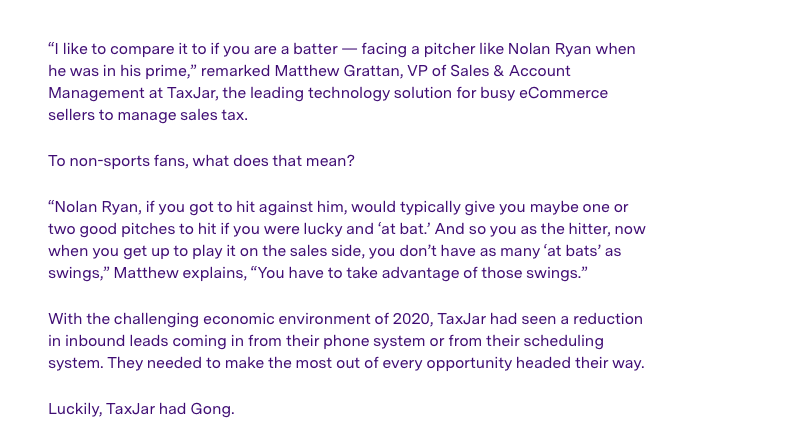
That first line, “I like to compare it to if you are a batter” is full of intrigue—another element of good storytelling. Gong’s creativity here reflects well on their brand. If they think outside the box (cliche alert!) in their case studies, it follows that they’ll be just as cool and creative to partner with.
Saying all of that, the opening could be tightened up. Impatient readers might give up, considering they need to read two lengthy quotes before they see where the story’s going. Personally, I’d have written something like:
“I like to compare it to if you’re a batter facing a pitcher like Nolan Ryan when he was in his prime,” says Matthew Grattan, VP of Sales and Account Management at TaxJar.
To non-sports fans what does that mean?
“He’d typically give you maybe one or two good pitches to hit if you were lucky. It’s like that in our sales team – you just have to take advantage of every swing.”
Or something in that ballpark—excuse the pun.
Here’s another quirky story opener that uses intrigue and suspense to engage readers. Here, Gong actually starts the story well into the customer’s journey with Gong. This makes a refreshing change from so many studies that start at the beginning with ‘X had this problem’.

I love this. The writer had a great quote that showcased how wowed staff were when they learned about Gong. So they led with it, used it for maximum impact, and then circled back to tell the story.
The reader has been taken on a journey. Hopefully, they’ll feel inspired enough by the social proof they’ve read, and the awesome writing, to take action.
Being specific about how customers use their product
Being specific about customers’ challenges and how you solve them is essential for creating impactful case studies. And Gong does it well.
They’re good at describing in fairly granular detail how customers use—and win—with their product. There’s not much fluff or generalized throwaway lines. They dive deep into the specifics, so readers can see exactly what it looks and feels like to work with them.
In their B2B case study example featuring Tray.io, Gong links into the solutions section of the study with a great line:
“We’ve detailed his (senior director of revenue operations) team’s successes below. Give a thought to how your team might use Gong to nail down similar outcomes.”
Next, the study lists each use case with a clear header and snappy explanation. Here’s the first one…
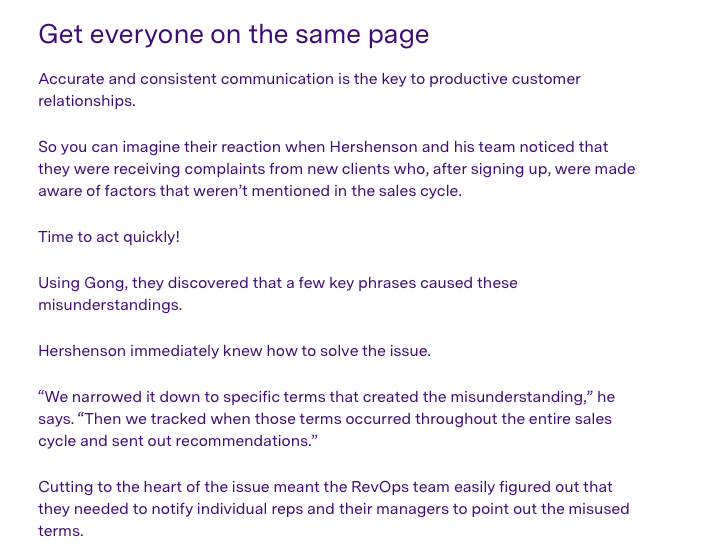
You get all the detail here and it’s written with style and pace. I love the mini paragraph, ‘Time to act quickly!’
The next section follows the same structure, explaining how the customer used Gong to solve a specific business problem that is relatable to other prospects.
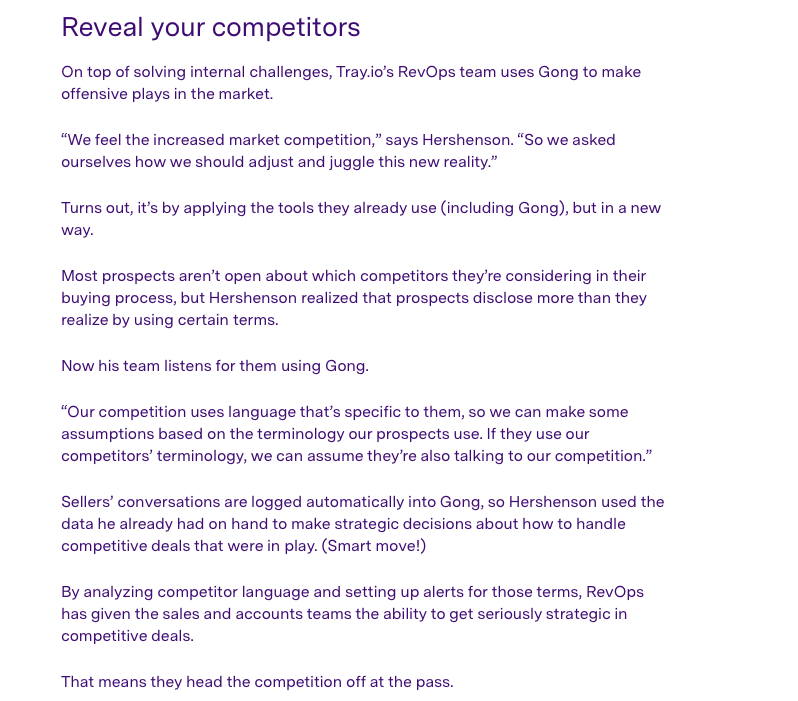
It has the same snappy style as before, short paragraphs, customer quotes that add value to the story, and enough specifics to keep prospects interested. Not to mention engaging turns of phrase, such as: ‘That means they head the competition off at the pass.’
By being as specific as you can in customer case studies, you give yourself the best chance of grabbing prospects’ attention, keeping them interested, creating a desire for what you do, and ultimately moving them successfully through your funnel.
Going big on metrics, but they could go bigger
Wherever possible, Gong uses metrics to add precision and proof to its case studies. However, in some cases I think Gong could make its metrics work harder. In a few of the studies I looked at, they simply dropped the numbers in raw, without providing much useful context.
For me, case studies are more powerful—and likely to incite action—when they spell out directly what those big numbers really mean in terms of tangible business impact.
Let’s look at a couple of examples.
In this study with customer Tinuiti, they have a great metric and they’re sure as hell going to shout about it!
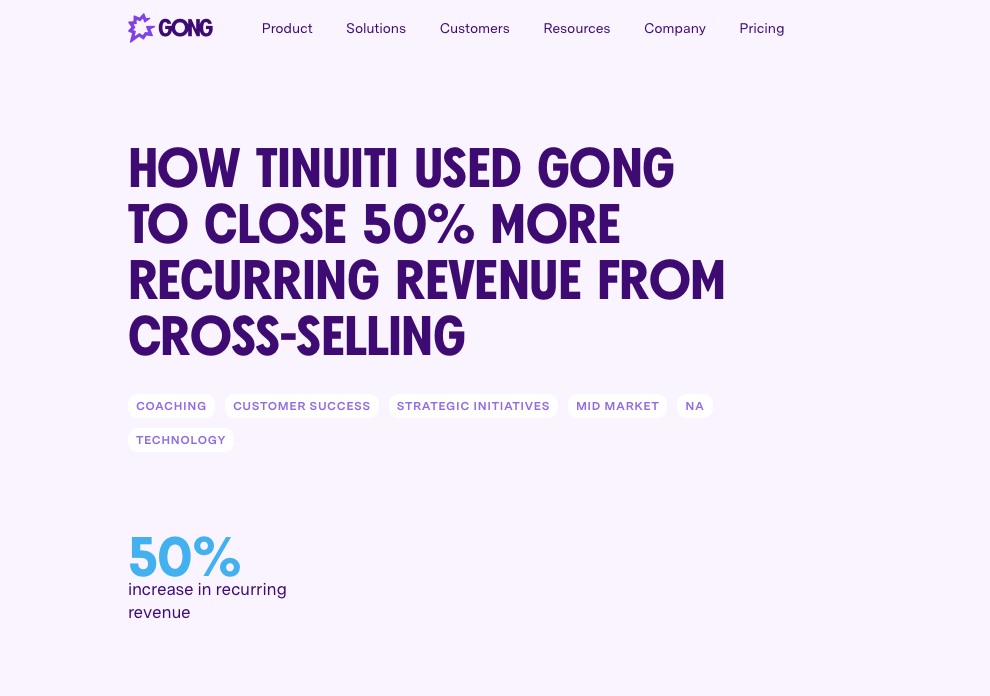
It’s a strong and convincing headline statistic. But, as you read on, Gong fails to build on its impact, simply repeating the same stat: “In fact, these keywords have bumped up cross-selling at Tinuiti, a 50% increase in recurring revenue from cross-selling year-to-date vs. the prior year, to be exact.”
Prospects are left with a “so what?” feeling here.
For me, this section of the study would be more dynamic if Gong explained what the 50% rise means for their customer moving forward.
Does more recurring revenue mean less time and money spent acquiring new customers? Will they invest these savings in building customer loyalty? Will they have greater business stability and improve future forecasting and planning?
This is what I want to hear about.
Here’s another example. It’s Tray.io again.

Again, they’ve shared metrics so juicy they’re making a mess of my computer desk (no harm done, it’s a mess already).
But again, Gong doesn’t expand on what that really means for the future of the business. Worse, they say: “Imagine the effect those numbers would have at any organization.”
The thing is… I don’t want to imagine it. I want Gong to tell me exactly what impact their product has had on this business, so I can project it on my own.
In my opinion, Gong should spell out that this jump in ACV means increased customer loyalty and retention, lower customer costs, increased deal size—or whatever the impact has been or will be.
By explaining the tangible, on-the-ground impact of metrics—and putting some snazzy clothes on naked numbers—you take out the guesswork for your prospect and (probably) increase the chances they’ll take action.
Reflecting a confident brand voice through conversational language and humor
One more thing I love about Gong’s customer success stories is their conversational nature and regular injections of humor to lighten the tone. Humor only works when you really know your subject, something that Gong clearly does.
Here’s an early paragraph from a study they did with Corporate Traveler:

I like that. A small dig at Excel which takes you by surprise as a reader and makes the case study more memorable.
Here’s another piece of Gong writing that made me smile…

Humor like this is important. Let’s be honest, B2B marketing can sometimes get a bit serious. If humor’s used in the right way, it doesn’t compromise your professionalism. It helps connect and engage readers with your brand, showing you’re down to earth and probably great to work with!
Conclusion
Gong gets so many things right with its SaaS case studies that other companies could be wise to reproduce.
If you’re looking for more inspiration, read our analysis of SaaS company Stripe’s customer success stories.
By following Gong’s lead on creative storytelling, specificity, and humor, as well as taking the time to organize and promote collateral so the right prospects find it, more businesses could turn insipid or invisible customer case studies into rocket fuel for your sales funnel.
If you’re not sure how to accomplish that, let us help you fire up your case study program.
Contact us to learn how we can help.